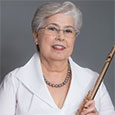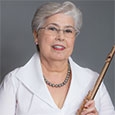Question: I have been saving for a new flute. Can you offer some tips on how to select a new instrument?
Answer: One of the most important things flutists do is choosing an instrument. Finding the right flute is something you likely will do a number of times.
Starting from the beginning are the student instruments everyone begins on. A beginner’s flute is usually chosen for the student or handed down from a family member. Hopefully, it is in good shape with the pads sealing well and has a good scale.
The second instrument for most will be an intermediate flute – perhaps the student’s first with open hole keys. This is when you will want to involve your teacher – a person who knows you and your abilities and can steer you in the right direction. You will be looking for an instrument with a good sound that is even up and down the scale, good intonation, good projection, and an excellent mechanism. Pay attention to how it feels in your hands as there will be subtle differences between the makes of flutes. If your teacher is not available, many of the vendors have excellent flutists on their staffs who can help you.
Your next flute will most likely be your first professional-level flute. When I was a student, flutists placed an order and waited for years. A month before the flute was ready, you received a bill from the flute company for the full price. When the flute arrived, that was it. Hopefully, you liked it, but if not, it was your responsibility to find another buyer for it.
In my youth most flutes were made with C-footjoints. A B-footjoint was a special order. The legendary French flutist Jean-Pierre Rampal actually liked a D-footjoint for Baroque music. Years later one manufacturer made a convertible footjoint to give the option of a D-, C-, or B-footjoint. Once B-footjoints became common, a new key arrived – the gizmo or high C facilitator. It was a special-order item, and I eventually had it added on to a couple of my flutes. The purpose of the key was to be able to play a soft high C.
In those long ago days, headjoints were not thought of in the same way as they are now. While it was possible to go to the flute company and try headjoints, most played on the headjoint that arrived with the flute. When I was still in high school, I went to Boston and tried a number of headjoints for an order that was four years away. I chose a beautiful headjoint that played very easily, the style of which was played by a famous flutist of the time. I made a very common mistake and chose something that played close to what I was used to. Also, I did not know that it was possible to have a beautiful headjoint and a beautiful flute that did not match. By the time I was ready to purchase a flute, a completely different headjoint was called for. Now that flutists know the importance of the headjoint, having another set of ears is valuable for making a good decision, so ask your teacher to help you.
During this time craftsmen who only made headjoints appeared on the scene. Their experiments led to some amazing discoveries. Headjoints are made in a variety of metals (14K, 18K, 10K, 9K, bonded etc.). Then there is the option of having a different metal for the riser or crown. Adding the extra weight of a gold or platinum riser can change the sound enormously, usually making the tone darker. Embouchure holes now feature under-cutting and upper-cutting and there are different thicknesses of the tube (.14, .15, .16, .18).
Most flute shops offer a trial period option before purchasing. Take full advantage of this time. Try everything you can on the instrument such as playing loudly and softly in all registers. Look for ease of playing throughout the range and check the intonation with a tuner. Try tonguing in all registers and pay attention to the ease or inherent difficulties in the response of the flute. Most dealers also offer a free headjoint exchange for a year after purchase.
Flutists have gone from having basically no choices to having more than could be imagined. There is almost an embarrassment of riches. So, when faced with all of these choices, what do you do first? I play a chromatic scale from top to bottom checking for homogeneity of the sound (timbre). If I like the sound, then I will play high notes really softly. I am looking for comfort or ease, good intonation and a beautiful sound. Next, I audition the lower octave assessing how much work it takes to play with full volume. Then I tongue in all octaves looking for clarity of sound with a minimum of effort. New flutes have a slightly different feel than one that is broken in, so it may sound a bit stiff and hard (not the key action, but the sound). The sound will indeed change and warm up as you play, however. This can begin even in the first few moments you play the instrument.
If I am satisfied with all of these things and the intonation is solid, I will play a few solos or excerpts. Favorites of mine are Bizet Carmen solo, the Griffes Poem (checking the C#s and quality of sound in the opening) and the Ravel Daphnis et Chloe solo. If I am satisfied, then the Mendelssohn Midsummer Night’s Dream Scherzo is next. After that perhaps Bach (either C.P.E. or J.S. unaccompanied) or whatever I am working on at the time.
I feel strongly that adding a wonderful headjoint to an inexpensive or inferior flute – while it will somewhat improve the flute – basically yields a wonderful headjoint with an inferior flute and not a great flute. It is important to have both a wonderful body and a wonderful headjoint. If they are a good match you will feel the entire flute working as a unit.
Choose a flute that offers a big improvement over your previous instrument and especially has a fuller sound with a larger dynamic range and color palette. It is very important that the flute feels comfortable to you. Having someone else play the flute is not the best way to choose a flute. Your new flute should help you do things well that you were not able to do before. If you are comfortable with the flute, you will play your best.
The sad thing is that flutes do not last a lifetime. Three times in my career I have “played out” my flutes. The first time was terribly upsetting. I could feel the flute losing its sound during a live telecast. Afterwards, I went to the flute maker and every repair person I could think of, and no one could bring back the sound. It never vibrated with itself the way it had before. By the third time this happened, I just went ahead and bought a new flute without getting upset. My feeling is that when people have had a flute for a long time and then decide they no longer like the sound, it is not because they have changed but because the flute has changed. The good news is that this is a wonderful opportunity to find another great flute.
Once you have a professional job, you will want to have at least two flutes. It is important that they match as closely as possible. Several times on the day of a performance, I discovered that the flute I was intending to play had a problem. It was too late to go to the repair person, so I played on my other flute. In my last years at the Met, I had what all flutists dream of having – two flutes that were so close that I sometimes forgot which one I was playing! Having an inferior flute as your backup is not wise as you have a flute you will not want to play. Headjoints are not interchangeable as much as we would like them to be, so it is best to have a fantastic second instrument.






